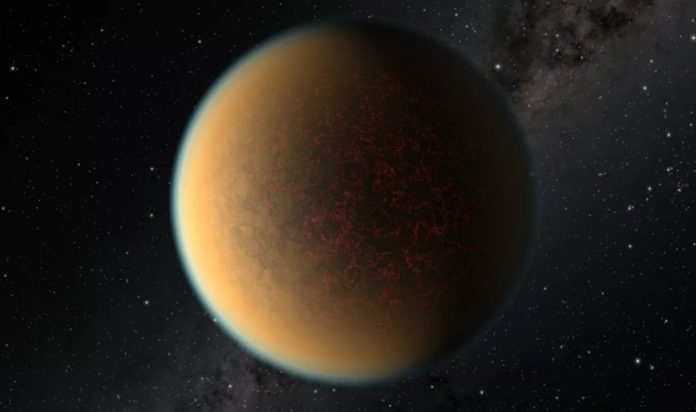A group of astronomers has discovered with the help of the Hubble Space Telescope evidence of volcanic activity on an Earth-like exoplanet. Hydrogen from its first atmosphere was absorbed by its molten magmatic mantle, and now it is slowly being released and forming a new one.
The GJ 1132, or Gliese 1132, is a red dwarf star isolated in the southern constellation Vela, which is about 40 light-years of the sun. In 2015 researchers discovered that the planet orbits it GJ 1132b, 1.6 times bigger than Earth. It makes a complete turn in just over 36 hours and several years ago the scientific community revealed that it has an atmosphere, although the planet is very close to its star and should have lost it a long time ago.
- Scientists in Fear of This New Predator From Red Sea Eating Native Species in Mediterranean
- Does This Mean We Stopped Being Animal and Started Being Human Due to ‘Copy Paste’ Errors?
- The One Lifestyle Choice That Could Reduce Your Heart Disease Risk By More Than 22%
- Aging: This Is What Happens Inside Your Body Right After Exercise
- Immune-Boosting Drink that Mimics Fasting to Reduce Fat – Scientists ‘Were Surprised’ By New Findings
A team of American and British researchers led by Mark Swain of NASA’s Jet Propulsion Laboratory (JPL) offered an explanation for this paradox.
Following data from Hubble and computer simulation of the evolution of the GJ 1132b, the authors concluded that the planet had lost its initial hydrogen and helium atmosphere during its first 100 million years of life, that its current atmosphere was the second, although it continues to fade into space, is constantly filled with the hydrogen reserve in the manthelic magma.
The high level of hydrocyanic acid – up to 0.5% – in the atmosphere of GJ 1132b also reveals its volcanic origin. It is rich in hydrogen, hydrogen cyanide, methane, and ammonia.
“This second atmosphere comes from both the surface and the interior of the planet. So it serves as a ‘window’ to the geology of another world,” says one of the authors of the paper, Paul Rimmer, of the University of Cambridge.
“Examining [the window] properly requires a lot of work, but opening it is very important,” emphasizes the expert.
According to the authors, GJ 1132b was born as a mini Neptune, straddling gas giants and planets like Earth. Initially, it had a thick layer of hydrogen and helium atmosphere that, however, quickly succumbed to the intense radiation of a hot star.
In the end, GJ 1132b has become a gas giant like Neptune about the size of Earth.
“At first we thought these planets were pretty boring since they lost their entire atmosphere,” explains another study participant, Raissa Estrela, of the Reaction Propulsion Laboratory at the California Institute of Technology in Pasadena.
“But when we looked at the data on this planet with Hubble, we realized that there was an atmosphere there.”
In that sense, GJ 1132b resembles Earth, as they are both similar in size, density, and age. Furthermore, they were both born with an atmosphere where hydrogen predominated, and both were hot before cooling down. Scientists even assume that GJ 1132b and Earth have similar atmospheric pressure near the surface. However, the chronology of their formation differs greatly.
“It turns out that not all the planets of the terrestrial group are formed like our planet. Some of them can form as mini Neptunes and then become similar to the Earth thanks to a mechanism by which the star evaporates the first atmosphere”, explains the chief of the study, Mark Swain. “The star cools, but the planet remains. During the first 100 million years the atmosphere evaporates, and then everything calms down. And a mechanism that recovers the atmosphere comes into operation.”
Scientists think that the exoplanet’s layer is continually heating up due to tidal heating as the energy from the planet’s spin is transformed into heat within it. Another example of this process is Jupiter’s satellite, Io, where continuous volcanism is supported by a play of the tidal chord between Jupiter and neighboring satellites.
- Scientists in Fear of This New Predator From Red Sea Eating Native Species in Mediterranean
- Does This Mean We Stopped Being Animal and Started Being Human Due to ‘Copy Paste’ Errors?
- The One Lifestyle Choice That Could Reduce Your Heart Disease Risk By More Than 22%
- Aging: This Is What Happens Inside Your Body Right After Exercise
- Immune-Boosting Drink that Mimics Fasting to Reduce Fat – Scientists ‘Were Surprised’ By New Findings
The article on the results of the study was published on arXiv.org.
